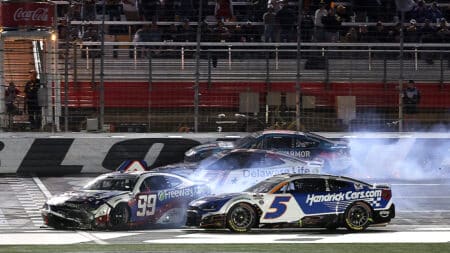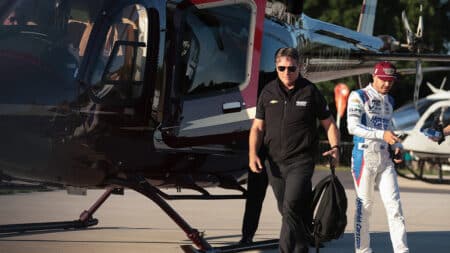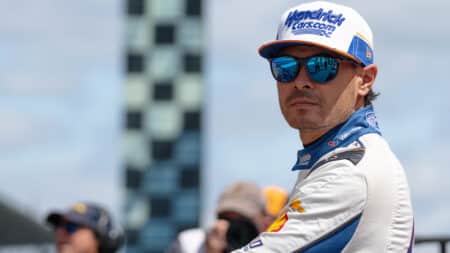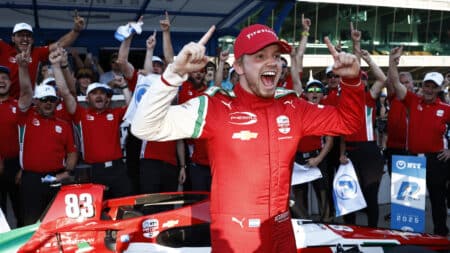
'Double isn't worth it', says Larson after 2025 attempt ends in disaster
Two crashes left Kyle Larson's hopes of completing the Indy 500 and Coca Cola 600 double in tatters — but did he even stand a chance in the first place?
A series taken from the 164-page Motor Sport special Great Racing Cars, which is available to buy here
From the editor Damien Smith
How would you define a ‘great’ racing car? Race wins and championship titles are an obvious place to start – and admittedly, when we began the process of rounding up the ‘voices’ to fill this special magazine, published by the team behind Motor Sport, we had in mind the likes of the Lotus 72, Ferrari F2004, Porsche 917, Audi R10 and so on.
But as the interviews of familiar racing figures began, we realised greatness is often a very personal thing. Naturally, most – but not all – would pick cars they had experienced first-hand, as a driver, designer, engineer or team boss. And on occasion the cars that stood out in their minds as ‘great’ weren’t necessarily so in the grand scheme of history. That’s why you’ll find a Minardi here among Formula 1 cars from Lotus, Williams and McLaren.
Unexpected? Certainly. Wrong? Not to the man who chose it.
As the interviews accumulated, our magazine took on a life of its own, full of personal anecdotes about the myriad cars that made careers. Some of those we spoke to, such as Mario Andretti and Dan Gurney, couldn’t be tied to a single choice from multi-faceted lives at the wheel. Such heroes have earned the right to choose an F1, sports and Indycar, so we allowed them more than one bite.
Others refused to be confined by category. Hence the short ‘Odd ’n Sods’ chapter on cars that, by and large, are mere footnotes in lower divisions of racing lore.
Thus there is nothing definitive about the selection listed herein. Then again, there’s no claim that this compilation offers the ‘Greatest Racing Cars’ of history. It’s much more personal than that, much more quirky – and all the better for it.
Gil de Ferran
Two-time CART champion and 2003 Indy 500 winner
The one that really sticks out in my head is the 2001 Penske/Reynard-Honda. We spent the 2000 season with Penske working on the Reynard. The team had a whole bunch of ideas of how we wanted to develop the car.
They built all their own suspension and we had a different aero package and all of those things came together on the 2001 car. That, without question, is the best Indycar I’ve ever driven.
It was a great car in every respect. It looked beautiful and was superbly finished, like all Penske cars. It was a Reynard built by Penske with the Penske level of quality, fit and finish. That car looked nice standing still. It made me proud to drive it. I was very proud to drive for Penske and Honda, but that was the epitome of it all.
On road courses it was a great combination of a really well-balanced car with a very smooth engine and very consistent Firestone tyres. It was a fantastic combination and something I really enjoyed. We won the title with that car in 2000 and 2001 and set a world record in qualifying for the 2000 California 500, at more than 241mph.
The fastest-ever racing cars
Gordon Kirby recalls the Reynards that set a circuit racing speed record at the California Speedway

The fastest laps ever achieved by a race car were set in 1997 and 2000 by Mauricio Gugelmin and Gil de Ferran at the high-banked, two-mile California Speedway. In qualifying for the 1997 California 500 Gugelmin lapped his PacWest Reynard-Mercedes at 240.942mph. Three years later de Ferran qualified his Penske Reynard-Honda on pole for the same race at 241.428mph, establishing the closed-course speed record for a race car.
Over the next few years an increasing series of restrictions on aerodynamics and engines forever changed the face of Indycar racing by substantially reducing horsepower, speeds and the spectacle. Today, it seems unlikely that the speeds achieved by de Ferran and Gugelmin will ever be equalled or even approached. Gugelmin says, “I feel lucky we lived through an age when Indycars got to that level.”
De Ferran’s record lap, set on October 28 2000, was the product of Honda and Penske doing everything possible to take pole and earn with it the additional point de Ferran needed to help wrap up that year’s CART title. In those days CART boasted four engine manufacturers (Honda, Mercedes-Benz, Ford/Cosworth and Toyota) and five chassis constructors (Reynard, Penske, Lola, Eagle and Swift), and was much closer to F1 in spirit and investment than is today’s Dallara de facto spec car. The California 500 was the last of 20 races that season and de Ferran went into it with a five-point lead over Adrian Fernandez, who had kept himself in the title hunt by scoring points in all but three races. De Ferran sealed the first of two consecutive CART titles by finishing a conservative third in the race, two places ahead of Fernandez.
“Leading up to the race Penske did a lot of work on the aerodynamics to make sure our Speedway car was the best it could be and Honda came up with this stonker of an engine,” says de Ferran. “It made over 1000bhp. It was a qualifying engine with very little mileage. I recall its limit was 50 miles. So basically you could do two runs in the morning and then your qualifying run.
“When we went to qualify they put the qualifying map on the engine, which was a bit extra. The thing was a rocketship, and without the turbulence from other cars to disturb it, the car was just stuck on the ground.
“You’re running so little downforce that you can easily overdo it on the tyres. There are no tyre warmers in Indycar racing and I brought it up [to speed] really slowly and got it just right. I knew exactly what speed I was [doing] on the exit of every turn.
“When I did that 241 qualifying lap the car was perfect. I remember feeling everything through my hands. Going into Turn 1 I was telling myself, ‘Don’t lift! Don’t lift!’ You’ve just gotta believe in the car because on a big oval, if you wait to feel that the grip is there, it’s too late.
“As soon as I crossed the start/finish line they said over the radio, ‘You’ve got pole!’ At the time the most significant thing was getting pole and the point that went with it, because we were fighting for the championship. The record was great but at the time it didn’t seem very important to me. But as the years have gone by it’s changed. I think it was pretty cool we were able to make that record under racing conditions. A lot of record attempts are done in special conditions away from a race weekend. As far as accomplishments go, that is one of which I’m very proud.”
But Gugelmin points out that in practice prior to his 1997 record qualifying run he turned a lap at 242.333mph. “The unofficial record is still mine,” he says. “That’s the fastest lap ever, I guess.”
Roger Penske
Legendary US team owner

My favourite Indycar is our 1994 Penske-Mercedes-Benz we raced at Indianapolis with a 209 cubic inch, rocker arm Mercedes-Benz engine they called ‘The Beast’. Quietly, we took advantage of the stock-block rule for the Indy 500 which had been dominated by the Buick V6 turbo stock-block type engine running 55 inches of boost which was seven inches more than the standard, four-camshaft V8 racing engine most of us were using.
We saw we could build our own engine to those rules and we worked on it very quietly for a year and surprised everyone when we rolled out the engine for the start of practice for the Indy 500. We sat on the pole and dominated the race with our cars and won with Al Unser Jr and that engine. That was a great day for our team and company and it established my relationship with Mercedes-Benz like the Porsche 917/30 had done with Porsche.
Following that our dealership business with Mercedes-Benz expanded worldwide and I sold the Detroit Diesel engine manufacturing business to Mercedes.
Rick Mears
Four-time Indy 500 winner

The 1979 and ’82 Penskes are both favourites, but the other one that comes to mind was Nigel Bennett’s first Penske Indycar, the PC17, in 1988. It was such a nice-looking car. It had the right lines, the right shape and the right aero. Nigel did a great job of bringing style to functionality. It looked right and it was a beautiful-handling car.
That was a few years after I broke my feet and everybody was pointing to my feet as being a problem for me on road courses. But the first time we ran that car at Long Beach on a street circuit we had a quick time in the first practice session. Some people asked, ‘What are you doing different?’ And I said, ‘Nothing. It’s because the car is working and doing what I’m asking of it.’
I won my third Indy 500 with that car and my team-mate Danny Sullivan won the championship in 1988. So without doubt, that was a great car.

Two crashes left Kyle Larson's hopes of completing the Indy 500 and Coca Cola 600 double in tatters — but did he even stand a chance in the first place?

The crunch point of Kyle Larson's Indy 500 and Coca Cola 600 double bid will come as he races from Indianapolis to Charlotte in a complex procedure involving cars, helicopters and planes. Ryan Glenn will be co-ordinating it... by text message

Kyle Larson will once again attempt the double this weekend. He explains his plans to complete the Indy 500 and NASCAR's Coca-Cola 600 in one day and overcome the "PTSD" of last year's bid

Robert Shwartzman and Prema stunned the field by claiming pole position for the 2025 Indianapolis 500 in his first-ever oval race. Here's a look at how they pulled it off